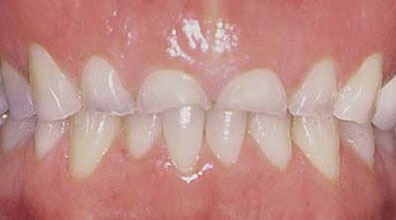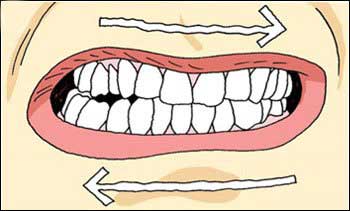BRUXISM
Regular grinding on teeth, from side to side, with excessive pressure; it starts as a result of certain factors but becomes a habit that is difficult to stop as time goes by. Some of the initiating factors include psychological stresses, some medical conditions and antidepressant drugs.
If left untreated:
- Wearing, flattening & increasing of tooth sensitivity.
- Abfraction (yellow depressions on tooth, towards the gum).
- Cracking and fracture of teeth.
- Pulp (innermost layer of teeth) inflammation.
- Gum inflammation with subsequent loosening of teeth.
- Dry Mouth.
- Bone bumps appear in the mouth as the body attempts to strengthen the bone to support and strengthen the grinding teeth.
- Square-shaped face; muscles on both sides of the face grow.
- Older face: vertical dimensions of the teeth decrease, cause the face to become shorter, the patient’s lips to be thin.
- TMJ roughness, ringing in ears, headache and limitation of jaw movement all due to joint overuse.
- Noisy grinding sounds while sleeping.
- Disturbed and restless sleep.
Treatment:
- Ask Bloom Dent for the Soft Mouth Guard (TMJ appliance or night guard) which is the most effective treatment for TMJ disorders. The device is used for at least 8 hours over night and one hour during the day; it directs joints into an unstrained position and relaxes the jaw muscles. Symptoms of TMJ disorders are reduced within one or two weeks, but the treatment should continue for six to eight weeks depending on the case.
- A course of glucose-amine tablets (three months-long) aids in strengthening joint cartilage (natural substances that lubricates the joint). This may be enhanced by intake of vitamin C.
- Hot packs applied externally on the joint and jaw muscles enhance blood flow, cleaning out and nourishing the muscles.
ABFRACTION
It is a yellow depression that appears on the front of the teeth near the gum line.
Causes:
- Brushing too hard using brushes with hard bristles.
- Bruxism: tooth becomes weaker as a result of the grinding and starts to bend from its weakest point (gum line), followed by dissolving of its tissue.
If left untreated:
The tooth becomes sensitive, due to the exposure of its inner sensitive layers (dentin), and its weakness makes it increasingly susceptible to fracture.
Treatment:
Use soft-bristled brushes and brush softly. Tooth grinding (bruxism) should be treated first, followed by white filling to restore the lost tooth tissues. If tooth grinding does not stop, the white filling will fall out of its place within a very short time.



